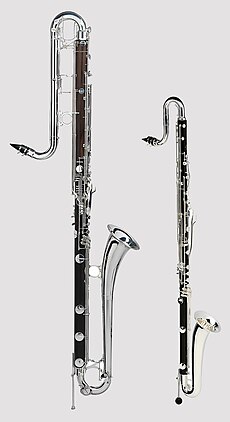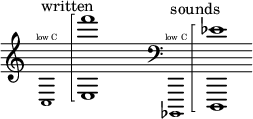
Back Clarinet contrabaix Catalan Kontrabassklarinette German Clarinete contrabajo Spanish Clarinette contrebasse French Clarinetto contrabbasso Italian コントラバスクラリネット Japanese Kontrabassklarinett NB
 Clarinets: contrabass in B♭ (left), contra-alto in E♭ (right) | |
| Woodwind instrument | |
|---|---|
| Classification | Single-reed |
| Developed | 1808 |
| Playing range | |
 | |
| Related instruments | |
| Musicians | |
The contrabass clarinet (also pedal clarinet, after the pedals of pipe organs) and contra-alto clarinet are the two largest members of the clarinet family that are in common usage.[1][2] Modern contrabass clarinets are transposing instruments pitched in B♭, sounding two octaves lower than the common B♭ soprano clarinet and one octave below the bass clarinet.[1] Some contrabass clarinet models have extra keys to extend the range down to low written E♭3, D3 or C3. This gives a tessitura written range, notated in treble clef, of C3 – F6, which sounds B♭0 – E♭4.[3] Some early instruments were pitched in C; Arnold Schoenberg's Fünf Orchesterstücke specifies a contrabass clarinet in A,[4] but there is no evidence such an instrument has ever existed.[5]
The smaller E♭ contra-alto clarinet is sometimes referred to as the "E♭ contrabass clarinet" and is pitched one octave lower than the E♭ alto clarinet.[1]
Two models of subcontrabass clarinet (the octocontralto and octocontrabass), lower in pitch than the B♭ contrabass, were built as prototypes by Leblanc in the 1930s and survive only as museum items.[6]
- ^ a b c "Contrabass clarinet". Grove Music Online (8th ed.). Oxford University Press. 2001. doi:10.1093/gmo/9781561592630.article.06357. ISBN 978-1-56159-263-0.
- ^ "Pedal clarinet". Grove Music Online (8th ed.). Oxford University Press. 2001. doi:10.1093/gmo/9781561592630.article.21171. ISBN 978-1-56159-263-0.
- ^ Adler 2016, p. 230.
- ^ Arnold Schoenberg, Five Orchestral Pieces (Courier Dover, 1999)
- ^ Baines 1991, p. 131.
- ^ Newton, Bret (6 November 2018). The True History of the Octo-Contra Clarinets? (video). Retrieved 11 October 2022 – via YouTube.
© MMXXIII Rich X Search. We shall prevail. All rights reserved. Rich X Search